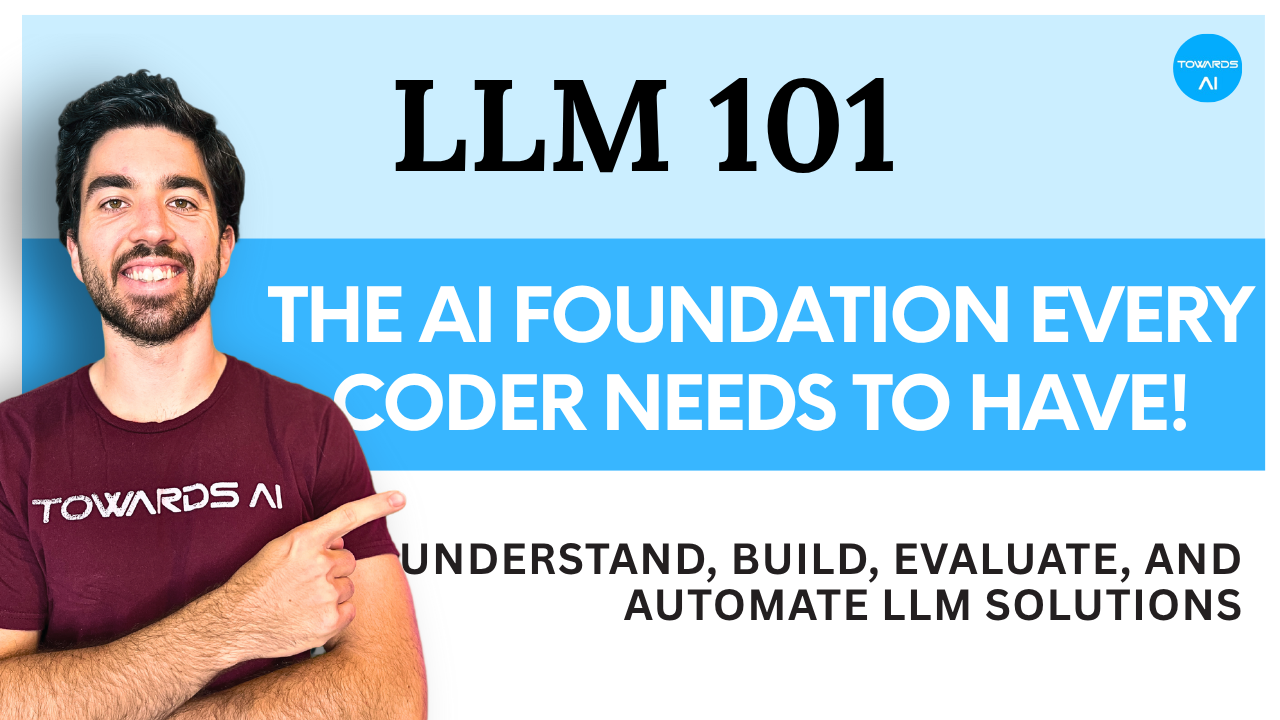Our developer-focused guide to LLMs, free!
A FREE 2-hour LLM Training (part 1)!

I am super excited to share our free two-hour presentation on the fundamentals of artificial intelligence (link here).
During this session, we dived deep into how language models work, their implementation, and the ways to overcome their current limitations. We spoke about competitive advantages, the different ways to interact with LLMs, and the reality of their statistical nature.
Watch it on YouTube :
Here are 10 key points to remember from this session:
- Large Language Models (LLMs) are no longer just buzzwords; they are actively used to generate profit, save money, and increase efficiency across various fields, including software development. Companies are seeing significant savings by encouraging their developers to use these models.
- More and more methods exist to mitigate the errors produced by LLMs, and early adopters are developing expertise that is highly sought after on the job market.
- A significant share of AI interactions involves programming, even though programmers represent only a small percentage of users, underlining the potential of LLMs in this area.
- LLMs are currently under-used in sales, marketing, and other domains, suggesting an opportunity for more specialized interfaces and tools.
- LLMs are not perfect “out of the box” and need additional features (such as RAG, fine-tuning, etc.) to control their randomness and improve relevance. Correctly integrating LLMs is crucial to avoid issues, as the Air Canada example showed.
- LLMs, built on the Transformer architecture, process information in several steps: tokenization (turning words into numbers), creation of embeddings (vector representations of meaning), then passing through attention and feed-forward blocks to understand context and generate text word by word (autoregressively). (Everything is explained in the video!)
- LLMs are trained in two key stages :
• Pre-training : The model learns to simulate the Internet by ingesting huge amounts of text to understand language and statistically predict the next word.
• Post-training (Fine-tuning + RL) : The model is refined with specific datasets (e.g., instructions and desired answers) and through reinforcement learning from human feedback (RLHF) to better follow commands and adopt desired behaviors. - Current limitations of LLMs :
• Hallucinations : Confident yet factually incorrect output, due to their statistical nature.
• Biases : Models reflect the biases present in their training data (the Internet).
• Finite Knowledge : Their knowledge is limited to the cut-off date of their training.
• Limited Context Window : Although growing, the amount of information they can process at once remains limited.
• No innate logic or sense of “truth” : They do not distinguish truth from falsehood and can be easily influenced, operating on probabilities rather than real understanding. - It is crucial to understand the statistical functioning of LLMs to integrate them effectively and avoid mistakes. Developers play a key role in building tools and features to offset their weaknesses (token streaming, history management, quality/cost calibration, model distillation).
- The field of AI is evolving very fast. Security and privacy considerations are important when using and developing with LLMs, notably by avoiding sharing sensitive information and controlling model access.
Watch now:
I hope you enjoyed this first training session! If you did, don’t forget to subscribe as we have many more of such sessions coming soon ;)
And now, what is this all about? A new 10-hour complete training, and this was just the first 2-hours of it!
Since 2023, I have been helping devs and data scientists bridge the gap between academic papers and real-world applications. The feedback is clear :
“Well structured and accessible; the learning process becomes incredibly smooth.” — Dan Duggan
“Impressed by the completeness and clarity; covers the whole spectrum of LLM engineering.” — Carlo Casorzo
“The best course to learn the latest RAG techniques.” — Patrick Drechsler
What you will learn in 5 modules (10 h) :
- LLM Fundamentals & AI 101 — understand transformers, their limits, and choose the right model. (what we just covered)
- Building on LLMs — advanced prompts, RAG, fine-tuning, and rapid deployment.
- Evaluation — auto metrics + human loop for quality & safety.
- Workflows & Agents — orchestrate reliable, cost-effective multi-step agents.
- Optimization & Monitoring — distillation, quantization, RLHF, and defense against prompt-hacking.
- Everything you need to know about re-training models! Fine-tuning tips, reinforcement learning best practices, and more.
- 🎁 Bonus : ready-to-use notebooks, lifetime access and updates.
Who is this training for?
- Developers, ML/AI engineers, product/tech leads, entrepreneurs.
- Know Python? Even better, but not mandatory.
- Ideal if you’re preparing a GenAI integration in a company, a side project, or a career pivot.
If you like the format, the full course (10 h) is available here : https://academy.towardsai.net/courses/llm-primer?ref=1f9b29 — launch price $199.99.
More feedback from learners :
“Built from the ground up and equipped for concrete use cases.” — Victor Palomares
“The course greatly widened my knowledge on RAG pipelines.” — Eoin McGrath
“Beyond the basics, it helps decide when and how to apply these techs.” — Mario Giraldo
“A clear roadmap to create practical LLM apps.” — Luca Tanieli
“Outstanding resource to master LLM development.” — Shashank Nainwal
“I learned a lot about deploying LLM apps.” — Martin Ballard
Ready to go from prototype to production? Take the training!
https://academy.towardsai.net/courses/llm-primer?ref=1f9b29
Questions? Happy to answer any questions on my socials or email!
